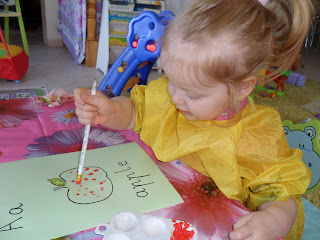I don't particularly like to do "explicit teaching" (Very structured teaching with an exact learning outcome) with my young children as I believe that forcing this style of learning upon them when they're not ready, or not interested, is not going to help in their future development or for their love of learning.
Any explicit teaching and learning that we do at home comes from my child's interests and almost all of their learning comes from real life experiences and play.
The reason we did this activity was because of my daughter's sudden interest in specific letters. Some things come about naturally, like knowing that "M" is for Madeline, but now she is interested in all other letters and is always asking what their names are and what certain words start with. This is how I knew she was ready.
Here is a cute way that I saw a long time ago out in the blogging world, (I wish I could remember where but alas, I cannot!) to help learn the letter A.
First I drew the apple shape, the letters (Both upper and lower case) and the word.
(I write in "Victorian Cursive" as it is the way that the letters are taught in schools in Victoria.)
After talking about the letter name and the sound it makes at the start of the word, "Apple" it was time to start painting
Using the rubber on the end of a pencil, she created dots all over the design, trying very hard to stay within the lines
This required a LOT of concentration and was a great way to practice hand eye coordination and fine motor skills
Some tips:
- In order to retain the information learnt in an activity, most children will need much reinforcement. Depending on your child's age or ability to retain information, they may need to be exposed to your area of learning a few times or many, many times.
- Keep talking to them about what they have learnt and asking them questions to help them recall the required information
- Extend this activity by having your child identify other items around the house that start with the same "a" sound as in "apple." Discuss the other sounds "a" can make. Find some of these words.
- For your information: When teaching letters to Preps (first year of Primary School in Melbourne, Australia. Ages 5-6 years approx), there were many different methods undertaken. In my last position, we generally focused on one letter a week and did many different activities to help reinforce the name, sounds, words etc. These were through crafts, writing, tracing, singing, dancing, creating and so on. Any possible way to help the children remember. Once a letter was "finished" for the week, we were always consistently re-visiting past letters in order to help the children retain the information.
- If you are attempting this activity with your child and they just don't seem interested, my advice would be not to push it. If they aren't engaged or interested then in my experience, the chances of them retaining the information will be greatly reduced and they will also be less likely to engage positively towards these sorts of activities in the future if they've had a negative experience.
- The key- Make it FUN!
Debs :)





